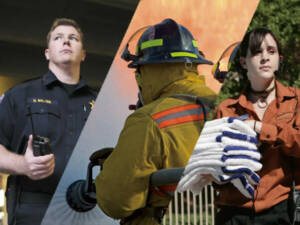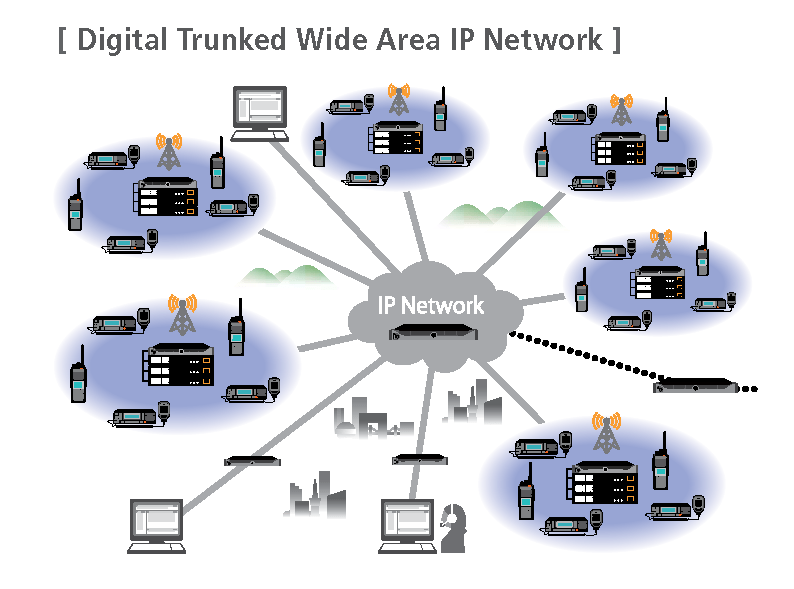
Digital – Digital Two-Way Radio’s provide greater clarity and range, along with increased features and capabilities, such as GPS enabled systems and data functionality (text messaging). All the sites are connected into a network, so the need for the dispatch office or a supervisor to be in radio range of a specific tower site is eliminated. Any radio in the fleet can talk to any other radio in the fleet provided both radios are in range of the network. The very narrow digital signal allows us to split the radio channels in quarters which quadruples call capacity and boosts efficiency. All Digital Two-Way Radios are compatible with analog devices and all Kenwood NEXEDGE radios that are currently in service have both analog and digital capabilities. This gives businesses the flexibility to purchase digital radios while continuing to operate in analog mode with their new radios along with their older analog radios (in analog mode), until most or all of their fleet is compatible with digital, at which time they can upgrade their radio fleet service to the digital network. This allows a gradual migration from analog to digital.
FCC Compliance
Our Diga-Talk network operates under the authority licensed to MRA by the Federal Communications Commission (FCC) for the use of the radio spectrum. All of our airtime customers that utilize our network operate under the authority granted to MRA by the FCC which negates the need for our subscribers to obtain an FCC license for operation on our network. Any radio operation by the subscriber that does not utilize our network does require an appropriate FCC license.
DIGA-TALK ARCHITECTURE
The architecture of the Diga-Talk Network is based upon the design of Kenwood, its creator. They have a 1st generation system and a 2nd generation system. Our network consists of both 1st gen and 2nd gen systems in California. In Colorado, our system is operating Gen I and will continue that way for many years.
The basic network architecture is depicted below. The network consists of tower sites that are connected via IP connection to all the other tower sites in the network per the figure below.

In the diagram above, each one of the shadowed areas represents a different radio tower site. Each site has a different coverage area. The network keeps track of the location of every radio on the network, so when you turn on a radio, it finds a tower site that covers the area on its own and sends a signal to the network to log onto the network. When a group call is placed, the network sends the signal to all locations that have a unit from that talk group so that everyone in the talk group can hear the conversation. If you move a radio out of range of one of the tower sites, the radio will look for another tower site. Once the radio finds another tower site in range, it logs onto the network from the new location. This is a similar function to the operation of a cellular phone.
Our local affiliate
The MRA system is maintained by our affiliate Collins Communications in Fort Collins, Colorado. They perform the routine maintenance at the tower sites as well as sell, install and maintain most of the radios on the network. If you have any issues with the system, need information about the system, wish to obtain airtime service, purchase radios, have equipment installed or removed or just want to talk to someone about what it can do for your communications requirements, contact:
Collins Communications
101 N Link Lane #1
Fort Collins, Co. 80524
970-493-6356 Voice
MRA DIGITAL RADIO COVERAGE
MRA has digital networked trunking located at 5 key sites around Colorado and we are planning to add additional sites. Each site on the network has been chosen to provide the unique coverage offered by that site to enhance the overall network coverage offered by MRA. All sites are connected together into a network, so it is not necessary to be using the same tower site as the person with whom you are conversing. Mobile radios will always provide the best range as they work in both the green and blue areas of the maps. Portable radios will provide communications while away from a vehicle or while inside of a building, but they will always have less coverage than a mobile radio as depicted in only the green areas of the maps due to the factors discussed in the article “How Far Will My Radio Talk?” which is located elsewhere on the website.
DISCLAIMER: In the maps immediately following, the green area represents the areas where all radios will work. The blue areas require the use of a mobile radio to have usable radio coverage. The white areas of the map do not have any usable radio coverage. All of our maps tend to be a little conservative, so you should be able to obtain coverage that is equal to or better than what is predicted. However, since the maps do not take into consideration local man made obstructions and trees, there may be some areas where the performance is below the predicted levels. A good rule of thumb is that the maps are about 90% accurate, but you cannot rely on absolute accuracy and we cannot guarantee coverage to be consistent with the performance indicated on the maps. If in doubt about the coverage, ASK FOR DEMO EQUIPMENT TO TRY OUT THE SYSTEM.

Click to view Rental ProgramsClick to view Diga-Talk Radio Products for Colorado
MRA AFFILIATE COVERAGE
MRA has an affiliate company that has digital networked trunking located at many key sites around western Colorado. Each of these sites have been chosen to provide the unique coverage offered by their network to enhance the overall coverage offered by MRA. They are connected to our network bridge so that you can use your radio in their coverage area while talking to another person in their coverage area or back home in the MRA coverage area. Mobile radios will always provide the best performance while portable radios will provide communications while away from a vehicle or while inside of a building, but they will always have less coverage than a mobile radio due to the factors discussed in the article “How Far Will My Radio Talk?” which is located elsewhere on the website.
The coverage depicted below represents the coverage of their entire network based upon using a mobile radio. The coverage of a portable radio will be significantly less.
DISCLAIMER: In the maps immediately following, the yellow area represents the areas where radios will work with varying degree of performance. The white areas of the map do not have any usable radio coverage. All our maps tend to be a little conservative, so you should be able to obtain coverage that is equal to or better than what is predicted. However, since the maps do not take into consideration local man-made obstructions and trees, there may be some areas where the performance is below the predicted levels. A good rule of thumb is that the maps are about 90% accurate, but you cannot rely on absolute accuracy and we cannot guarantee coverage to be consistent with the performance indicated on the maps. If in doubt about the coverage, ASK FOR DEMO EQUIPMENT TO TRY OUT THE SYSTEM.

Click to view Rental ProgramsClick to view Diga-Talk Radio Products for Colorado
MRA TECHNICAL DIGITAL RADIO COVERAGE
The following maps depict the MRA Digital radio network coverage in greater detail than the maps above. There are eight main color levels of signal quality along with different shades of the various colors which shows gradual changes in signal strength. Each color (such as from red to yellow, yellow to green, green to turquoise, turquoise to blue etc.) represents a signal strength reduction of ten times weaker except the color change from magenta to red which represents one thousand times weaker signal. Mobile Radios will work well down to the dark blue areas, have some issues in the grey areas and not work at all in the white areas. Portable radios will work well down to the green areas and start experiencing some difficulty in the turquoise areas. Using a portable radio while inside a moving vehicle will have difficulty in the turquoise area and is typically not possible in the blue areas. To use a portable radio in the blue areas, one must exit the vehicle and find a “hot spot” and stay in the hot spot to communicate with the radio. Please see the discussion in the article “How Far Will My Radio Talk?” which is located elsewhere on the website.
DISCLAIMER: In the maps immediately following, the various colors represents areas of different performance. All radios will work extremely well in the magenta areas, very well in the red areas, work well in the yellow areas and work reasonably well in the green areas. The turquoise blue areas are a bit unreliable for portable radios and very unreliable in the blue areas, but mobile radios should work well. The gray area is marginal coverage for a mobile radio and the white areas of the map do not have any usable radio coverage. All our maps tend to be a little conservative, so you should be able to obtain coverage that is equal to or better than what is predicted. However, since the maps do not take into consideration local man-made obstructions and trees, there may be some areas where the performance is below the predicted levels. A good rule of thumb is that the maps are about 90% accurate, but you cannot rely on absolute accuracy and we cannot guarantee coverage to be consistent with the performance indicated on the maps. If in doubt about the coverage, ASK FOR DEMO EQUIPMENT TO TRY OUT THE SYSTEM.



Click to view Rental ProgramsClick to view Diga-Talk Radio Products for Colorado
MRA AFFILIATE TECHNICAL DIGITAL RADIO COVERAGE
The following map depict the MRA Affiliate Digital radio network coverage in greater detail than the maps above. There are eight main color levels of signal quality along with different shades of the various colors which shows gradual changes in signal strength. Each color (such as from red to yellow, yellow to green, green to turquoise, turquoise to blue etc.) represents a signal strength reduction of ten times weaker except the color change from magenta to red which represents one thousand times weaker signal. Mobile Radios will work well down to the dark blue areas, have some issues in the grey areas and not work at all in the white areas. Portable radios will work well down to the green areas and start experiencing some difficulty in the turquoise areas. Using a portable radio while inside a moving vehicle will have difficulty in the turquoise area and is typically not possible in the blue areas. To use a portable radio in the blue areas, one must exit the vehicle and find a “hot spot” and stay in the hot spot to communicate with the radio. Please see the discussion in the article “How Far Will My Radio Talk?” which is located elsewhere on the website.

Click to view Rental ProgramsClick to view Diga-Talk Radio Products for Colorado